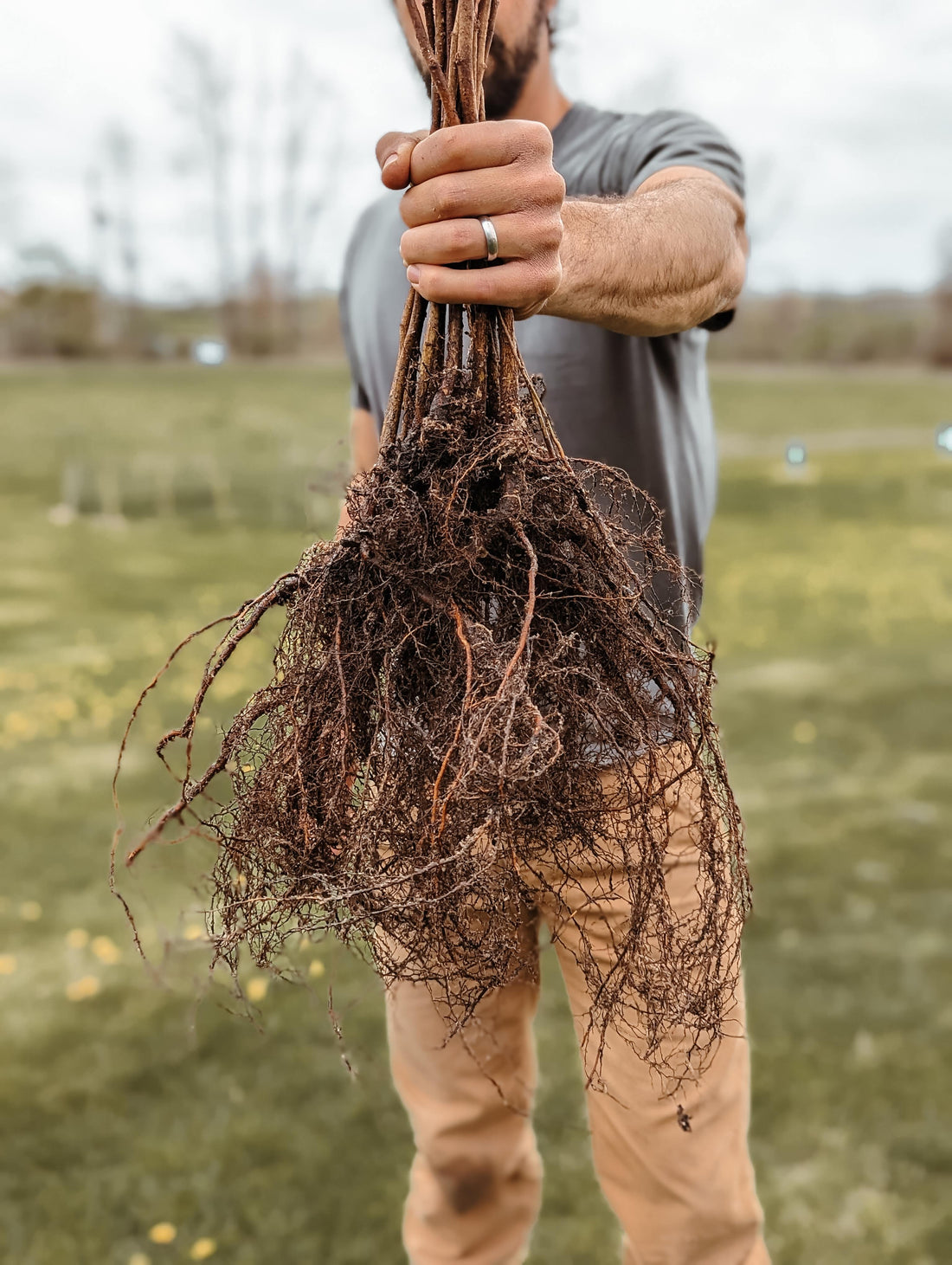What is a bare root tree?
Are bare root trees better than potted trees?
Those are valid questions and I'll answer both. In the nursery world “bare root” is a term used to refer to trees (or other plants) that have been grown in the ground or in specialized air prune beds, dug up after the tree is dormant and the soil has been shaken, washed or otherwise removed from the root system (I'll be writing a follow up post about air pruning and its benefits soon, so keep an eye out for that!). Quite simply a bare root tree is exactly what it sounds like: a tree with bare roots. Below is a bare root elderberry plant grown from a hardwood cutting. You can clearly see the tremendous amount of roots and nice spreading structure of the root system.

Bare root trees are the counterpart of container grown trees or potted trees, whose roots are never bare, even when transplanted from the pot into the ground.
But why bother with bare root trees? Are bare root trees better?
At Humble Roots Tree Farm we, along with many others, feel quite strongly that bare root trees are far superior to their containerized brethren, but they do come with some challenges. We’ll look at the main pros and cons.
The pros:
- The root systems of bare root trees are allowed to grow naturally without the constraints of a container forcing roots to grow in unnatural and unhealthy ways. When grown in pots or other containers, roots will hit the wall or bottom of the container and start circling the smooth walls of the pot creating “girdling roots” that can grow around the trunk of the tree inhibiting vascular function, which can ultimately kill a tree or at the very least cause poor growth.
- Bare root trees will grow faster and adapt more quickly to their new surroundings than will containerized trees. This is because the roots haven’t been potbound in a container and can quickly spread out in their new home. Also, because the roots, once planted, are in contact with only the native soil of the new location the trees are forced to adapt quickly to the new soil whereas a the roots of a potted tree will have the nutrient rich potting soil still in the root ball and may choose to continue growing in that area rather than spreading far and wide to find nutrients.
- Bare root trees are very light and easy to handle, which means they can be shipped and transplanted much more easily than containerized trees. This also means they are usually quite a bit cheaper than potted trees.
The cons:
- Bare root trees should only be dug up for transplanting while they are dormant. Digging up a tree during the growing season causes a great amount of stress on it and many times a tree will not survive transplant if dug during active growth. Practically, this means that bare root trees can only be dug and transplanted in either the fall after dormancy has begun or in the early spring before dormancy breaks. While this may seem like a limitation, ultimately spring or fall is a much better time to plant anything (bare root or potted) as the weather is usually mild and there is often adequate rain and soil moisture. Even potted trees whose roots are protected by soil during the whole transplant process may struggle to adapt to its new home if it’s planted in the middle of the hot, dry summer weather. Fall or spring is a much easier time to make these transitions for any plant.
- Because the roots of a bare root tree aren’t protected by soil once harvested, there is potential for the roots to dry out and die. This, however, can easily be managed though by keeping the roots packed in moist media like sawdust or coco coir until they are shipped or heeled in for the winter.
- Bare root trees are typically young and relatively small trees. If you are looking for an immediate impact like fruit to eat or shade to sit under within the first season or two then bare root isn’t the way to go, but bare root trees will grow faster than potted trees and usually overtake their containerized counterparts within a few seasons. If you are willing wait just a bit longer, bare root trees will give you all that you are looking for and much more while also ensuring a higher likelihood long term success.
I hope this little primer has been helpful in understanding what a bare root tree is and why you might want to consider buying bare root trees for your next planting. Be sure to check out our selection of bare root trees for sale online and available for local pick up. We offer fruit and nut trees like apples, peaches, plums, chestnuts, hazelnuts as well as berry shrubs like seaberry, honeyberry, currants and goji berry. Thanks for reading and feel free to reach out with any questions. I’d be happy to help!
